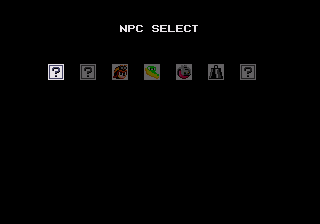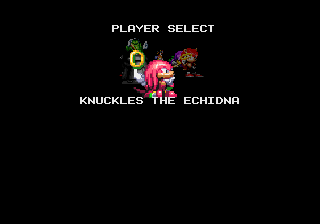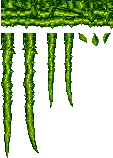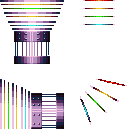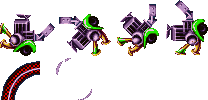Proto:Knuckles' Chaotix/1207 Prototype
This is a sub-page of Proto:Knuckles' Chaotix.
To do:
|
Prototype 1207 is the earliest available build of Knuckles' Chaotix, compiled December 7, 1994. It was released by drx during the February 23, 2008 proto release; on Kega and PicoDrive (RetroArch) a special savestate (provided) below is required due to the "SEGA!" chant being messed up by the driver. Optionally, you can also bruteforce it by hard-resetting a couple times.
| Download Knuckles' Chaotix (1207 Proto)
File: Knuckles' Chaotix (Prototype 1207).bin (3 MB) (info)
|
| Download Savestate past the Sega screen (for Kega Fusion)
File: Chaotix 1207 After Sega.zip (92 KB) (info)
|
| Download Savestate boot for PicoDrive (RetroArch)
File: Chaotix Savestate boot.zip (79 KB) (info)
|
Contents
Sub-Pages
| Levels Intro Stage, World Entrance, Botanic Base, Techno Tower, and Marina Madness. Amazing Arena and Speed Slider are both unfinished. |
General Differences
Sega Screen & Menus
| Prototype 1207 | Final |
|---|---|
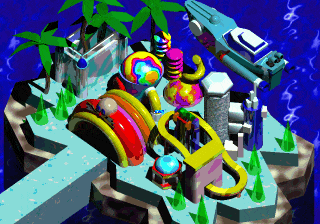 |
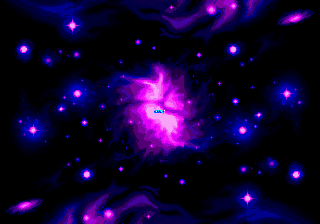 |
The Sega screen uses a promotional image of Newtrogic High Zone, the final changed this to the Game Over/Level Beat screen instead. The Sega logo lacks the "TM" and instead of zooming in, the Newtrogic High image fades to black, leaving the Sega logo in the dark for a few seconds.
| Prototype 1207 | Final |
|---|---|
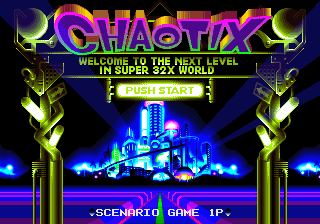 |
 |
The title screen is in a somewhat preliminary state:
- No intro sequence is present.
- The main characters are absent, and their graphics do not exist in the ROM.
- The Chaotix logo has no palette cycling, nor does it have the TM mark.
- The "Push Start" sign is more basic.
- The main menu is where the copyright text would be.
- Selecting OPTION brings you only to the Sound Test, which is a very basic screen: a black background with white text.
- Cheat menus are accessible by highlighting OPTION, then pressing A + Start for Color Test, C + Start for Sound Test (with preliminary graphics), or B + Start for Jam Out mode (which acts similar to ToeJam & Earl).
- In Jam Out mode, press A, B, C, or Start to play the many different PWM samples. Buttons on the D-Pad can be held to change between sound banks. A + B + C + Start will exit the Jam Out menu.
| Prototype 1207 | Final |
|---|---|
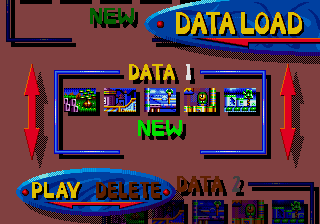 |
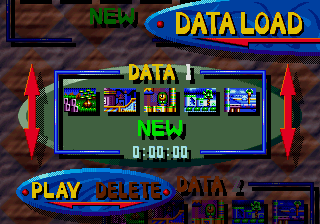 |
The save menu is in an earlier state than the title and is very buggy:
- The background isn't present yet.
- Controls are reversed (Up moves down, Down moves up).
- Level numbers in the save files do not render properly.
- Selecting file 1, 2, or 3 may place you instantly in the World Entrance with two Espios. Selecting "No Save" will start the game normally.
| Prototype 1207 | Final |
|---|---|
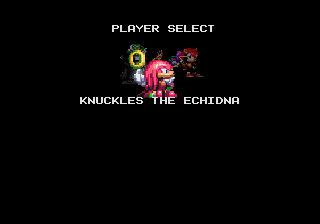 |
 |
Incredibly bare bones at this point; there's an empty slot after Knuckles (likely meant for Tails, see below) and the player has the option to choose Heavy and Bomb, which are only Combi Catcher characters in the final.
The Combi Catcher is even more barebones, not even a level; instead, whenever the player exits the hub to the right, this screen pops up; the first question mark is Mighty, the second question mark is unselectable (again, likely Tails) and the third question mark is Espio; upon selecting your partner, a level select popup.
Unused Time Attack Screen
A strange oddity occurs in this prototype. Normally, selecting the "TIME ATTACK" option on the title screen brings you to the prototype's usual rudimentary character select menu and the "ATRACTION SELECT" screen. Selecting this option will boot into a player selection screen, followed by an NPC selection screen. Normally, you would just enter the regular stage selection screen, but you can access the actual "TIME ATTACK" menu by performing 2 full rotations to the right in the player selection screen. What's going on is that whenever you move the player selection, the word (2 byte) value at address 0xFFFAC0 will be incremented or decremented by 0x20. Due to the fact there are 8 possible selections, a full rotation will result in an increase or decrease of 0x100, making the top byte of it effectively being the rotation iteration ID, and that is what is checked to activate the "TIME ATTACK" menu.
As of the 1207 build, however, this screen contains some differences from the final game, and differences from later revisions. It contains a functional level select, with alternate level names, and what seems to be a simple graphical mockup of the results screen. Further revisions of the game would gradually remove/improve the "TIME ATTACK" option and ultimately replace it with the "TRAINING" option.
Alternate level names include:
- Botanic Garden (Botanic Base)
- Amusement Park (Speed Slider)
- Amazing Zone (Amazing Arena)
- Resort Hotel (Techno Tower)
- Marina Drive (Marina Madness)
And three "Time Attack Zones":
- Time Attack 1 - Loads alternate Isolated Island with Botanic Base's title card.
- Time Attack 2 - Loads another alternate Isolated Island with Botanic Base's title card.
- Time Attack 3 - Loads blank level with a nameless title card.
| Standard Zones | Time Attack Zones |
|---|---|
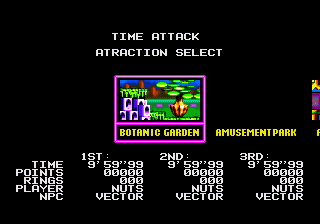 |
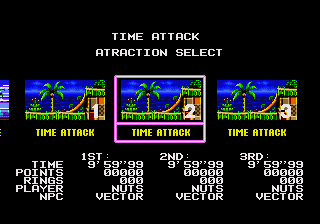 |
What's interesting is that one of the names listed on this results screen mockup is "NUTS". This is most likely referring to Mighty; an early prerelease screenshot shows that he was originally known as Nat, which is spelled like "nuts" in Japanese (ナッツ, natsu). All of the rank text is merely a placeholder, stored as a plain tilemap that gets loaded directly into VRAM.
lea Map_TimeAttackRankPlaces(pc),a1 ; Draw rank place numbers (1ST, 2ND, 3RD)
move.l #$53140003,d0
moveq #(192/8)-1,d1
moveq #(8/8)-1,d2
moveq #0,d3
jsr DrawTilemap
lea Map_TimeAttackRankLabels(pc),a1 ; Draw rank labels (TIME, POINTS, RINGS, PLAYER, NPC)
move.l #$54040003,d0
moveq #(48/8)-1,d1
moveq #(40/8)-1,d2
moveq #0,d3
jsr DrawTilemap
lea Map_TimeAttackRankData(pc),a1 ; Draw 1st place rank data (9'59'99, 00000, 000, NUTS, VECTOR)
move.l #$54160003,d0
moveq #(56/8)-1,d1
moveq #(40/8)-1,d2
moveq #0,d3
jsr DrawTilemap
lea Map_TimeAttackRankData(pc),a1 ; Draw 2nd place rank data (9'59'99, 00000, 000, NUTS, VECTOR)
move.l #$542A0003,d0
moveq #(56/8)-1,d1
moveq #(40/8)-1,d2
moveq #0,d3
jsr DrawTilemap
lea Map_TimeAttackRankData(pc),a1 ; Draw 3rd place rank data (9'59'99, 00000, 000, NUTS, VECTOR)
move.l #$543E0003,d0
moveq #(56/8)-1,d1
moveq #(40/8)-1,d2
moveq #0,d3
jsr DrawTilemap
Map_TimeAttackRankPlaces:
dc.w '1'-$20, 'S'-$20, 'T'-$20, ':'-$20, ' '-$20, ' '-$20, ' '-$20, ' '-$20, ' '-$20, ' '-$20
dc.w '2'-$20, 'N'-$20, 'D'-$20, ':'-$20, ' '-$20, ' '-$20, ' '-$20, ' '-$20, ' '-$20, ' '-$20
dc.w '3'-$20, 'R'-$20, 'D'-$20, ':'-$20
Map_TimeAttackRankLabels:
dc.w ' '-$20, ' '-$20, 'T'-$20, 'I'-$20, 'M'-$20, 'E'-$20
dc.w 'P'-$20, 'O'-$20, 'I'-$20, 'N'-$20, 'T'-$20, 'S'-$20
dc.w ' '-$20, 'R'-$20, 'I'-$20, 'N'-$20, 'G'-$20, 'S'-$20
dc.w 'P'-$20, 'L'-$20, 'A'-$20, 'Y'-$20, 'E'-$20, 'R'-$20
dc.w ' '-$20, ' '-$20, ' '-$20, 'N'-$20, 'P'-$20, 'C'-$20
Map_TimeAttackRankData:
dc.w '9'-$20, "'"-$20, '5'-$20, '9'-$20, '"'-$20, '9'-$20, '9'-$20
dc.w ' '-$20, " "-$20, '0'-$20, '0'-$20, '0'-$20, '0'-$20, '0'-$20
dc.w ' '-$20, " "-$20, ' '-$20, ' '-$20, '0'-$20, '0'-$20, '0'-$20
dc.w ' '-$20, " "-$20, ' '-$20, 'N'-$20, 'U'-$20, 'T'-$20, 'S'-$20
dc.w ' '-$20, "V"-$20, 'E'-$20, 'C'-$20, 'T'-$20, 'O'-$20, 'R'-$20
Other
- Pausing the game does not stop the music.
- The build is quite infamous for its poor PWM implementation which causes rather unpleasant sounds to play on certain emulators upon bootup (most notably Kega).
- The game's header and title cards refer to it as Knuckles' Ringstar, a name that was only used in very early promotional screenshots.
- Heavy's name is listed as "Heaby", a mistranslation due to Japanese not differentiating between "b" and "v".
- Knuckles has different climbing sprites, which were... thankfully touched up in the final.
- All 32X art is uncompressed. In the final game, most of the static art uses the C42 compression. Everything that uses the 32X VDP is viewable in this build.
- The cutscenes before the bosses are fully implemented, although the boss music starts directly in the cutscenes instead of playing "Have Some Fun".
- Items do not "pop out" of monitors, though graphics do exist for the animation.
- Spindashing into a monitor does not break it.
Gameplay Differences
- Every character except Espio has an ability programmed, though Vector can only climb walls and it's very tricky to do so. There are sprites for Vector's double-jump ability in the ROM, however.
- Vector's running animation is faster.
- If Vector is holding a character and jumps, there is no running animation like in the final.
- The line that holds two characters together is always blue.
- When clearing a level, "Mechanical Dance" plays instead of "From Party to Party".
- Free movement/Debug Mode is always enabled.
- The time-of-day system doesn't seem to be working at all. Each level you select after the World Entrance seems to have a time of day arbitrarily assigned to it. The World Entrance itself seems to always be daytime.
- Metal Sonic will not attack you if you are idle in a level. Likely done intentionally for testers.
- The timer infinitely loops during a level. Again, probably done intentionally for testers.
- Icons for your current powerup don't display at the bottom of the screen, unlike the final.
- When Mighty uses the wall kick, it is different and "automatic". It uses a sprite that goes unused in the final, and matches up with an unused sprite for Sonic in Sonic Crackers. Also of note is that the sound effect when he clings to a wall is different, using Vector/Espio/Knuckles' sound for when they cling to a wall.
- When Knuckles is climbing, you have to keep A/B/C pressed to climb, otherwise Knuckles falls off. In addition, the animation that plays when you move from wall to floor is a little more rough.
- When entering a Special Stage from a normal level, when the results screen is finished, the game incorrectly plays the "enter Special Stage" sound effect.
- The invincibility stars are very different - there's less of them (only two at a time, it seems), and they're small gold five-pointed stars. The stars also only surround the first player, unlike in the final where both players are surrounded.
- Buttons do not make any noise when pressed, but when they spawn they make a noise.
- Invincibility does not destroy enemies.
- The character switch monitor does not work.
- The "change your partner into someone else" monitor doesn't exist.
- Pressing A + B + C + Start during gameplay resets the game.
Level Differences
- Speed Slider levels 2, 3, 4, and 5 are the same.
- As with the final, the backgrounds change color depending on the time of day. The exception in this build is Amazing Arena, which just changes a window's color.
- Crumbling platforms use a different sound effect, very similar (if not identical) to those in earlier Sonic games.
- Enemies do not drop "battery rings" when defeated.
Early/Unused Graphics
| To do: See if there are any other sprite changes. |
| Artwork | Description | ||||
|---|---|---|---|---|---|
| A breakable block that would have been used in Botanic Base. | |||||
| Some unused sprites for the Botanic Base boss that show large thorns. | |||||
| Miscellaneous unused sprites for Isolated Island. | |||||
| A flying carpet. Used in the 0119 prototype in Speed Slider. | |||||
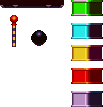
|
Miscellaneous unused sprites for Speed Slider. | ||||
| These sprites were likely supposed to be used with the tunnels that Speed Slider had in later prototypes. | |||||
| A scrapped enemy for Speed Slider. This was used in the 0119 prototype. | |||||
|
Some sort of enemy for Speed Slider. This had its appearance updated in the final game, though it still went unused. | ||||
| Graphics that look like Metal Sonic Kai's claws. | |||||
| Graphics spelling out "Sonic Crackers S32X" ("S32X" standing for "Super 32X"), confirming that Sonic Crackers is a Chaotix prototype. | |||||
| |||||
| An unused portrait of Isolated Island in the style of the other portraits. Used in alternate Time Attack screen. | |||||
| The end of level sign is completely different, missing the 3D effect seen in the final game. |
To do:
|
Characters
Several of the characters (namely Knuckles, Vector and Espio) have some different sprites compared to the final.
| Prototype 1207 | Final |
|---|---|
 |
 |
| Prototype 1207 |
|---|

|
Some of Knuckles' sprites have slightly different shading and overall looks.
| Prototype 1207 | Final |
|---|---|

|

|

|

|
Vector's run sprites have simpler shading and less motion; it's likely that the simpler shading is a hold over when the game was still being developed for Genesis, given the palette for him and Knuckles could already be found in Crackers.
Sonic and Tails
![]()
Graphics are in the ROM for Sonic and Tails monitors. The image above uses a palette that was unused in Sonic Crackers.
![]()
There is an empty space in the character selection menu following Mighty, who originally was Sonic. This space is believed to originally be reserved for Tails - the palette above is assigned to the character in the slot after Mighty, and contains many colors that were used in Crackers for Tails. In later Chaotix protos, the palette still exists but the character's palette pointer points to Mighty's palette instead. While most other characters in Chaotix use 18 entries + a transparent color for their sprites, this one only has 15 + transparency, indicating a leftover from earlier in development.
To properly play as Tails in this prototype, change the bytes at address 0x16060 from 03 CC to 04 F4. To fly, press Up and C in mid-air. Unlike later prototypes, Tails always jumps at full height, his palette remains intact, and while he uses broken Knuckles graphics as in the final, the animations are not as erratic. Unfortunately, Tails has a tendency to crash the game a lot, including on real hardware and in Kega Fusion. Currently, the most stable emulator for playing as Tails is Gens, though the proto itself is very unstable in that emulator.
Hidden Strings
Present at 0x6E1E is a small sound driver string. A partial version remains in the final ROM.
casablanca version by MILPO
Present starting at 0x3DC30 is the diagnostic menu text from the 32X version of After Burner.

